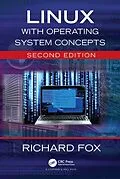A True Textbook for an Introductory Course, System Administration Course, or a Combination Course
Linux with Operating System Concepts, Second Edition merges conceptual operating system (OS) and Unix/Linux topics into one cohesive textbook for undergraduate students. The book can be used for a one- or two-semester course on Linux or Unix. It is complete with review sections, problems, definitions, concepts and relevant introductory material, such as binary and Boolean logic, OS kernels and the role of the CPU and memory hierarchy.
Details for Introductory and Advanced Users
The book covers Linux from both the user and system administrator positions. From a user perspective, it emphasizes command-line interaction. From a system administrator perspective, the text reinforces shell scripting with examples of administration scripts that support the automation of administrator tasks.
Thorough Coverage of Concepts and Linux Commands
The author incorporates OS concepts not found in most Linux/Unix textbooks, including kernels, file systems, storage devices, virtual memory and process management. He also introduces computer science topics, such as computer networks and TCP/IP, interpreters versus compilers, file compression, file system integrity through backups, RAID and encryption technologies, booting and the GNUs C compiler.
New in this Edition
The book has been updated to systemd Linux and the newer services like Cockpit, NetworkManager, firewalld and journald. This edition explores Linux beyond CentOS/Red Hat by adding detail on Debian distributions. Content across most topics has been updated and improved.
Autorentext
Richard Fox is a professor of computer science at Northern Kentucky University (NKU). He regularly teaches courses in both computer science (Artificial Intelligence, Computer Systems, Computer Architecture, Concepts of Programming Languages, Object-Oriented Programming I and II) and computer information technology (IT Fundamentals, Unix/Linux). Dr. Fox, who has been at NKU since 2001, is the current chair of NKU's University Curriculum Committee. Prior to NKU, Dr. Fox taught for 9 years at the University of Texas - Pan American (now known as University of Texas - Rio Grande Valley). Richard has received teaching awards from UTPA and from NKU, and a service award from NKU. Dr. Fox received a Ph.D. in Computer and Information Sciences from The Ohio State University in 1992. He also has an M.S. in Computer and Information Sciences from Ohio State (1988) and a B.S. in Computer Science from the University of Missouri Rolla (now Missouri University of Science and Technology) in 1986. Dr. Fox has written two other textbooks published by Taylor & Francis/CSC Press in the IT field (Linux and Operating System Concepts, 2015, and Internet Infrastructure: Networking, Web Services and Cloud Computing, with Dr. Wei Hao, 2018). Dr. Fox has also authored or co-authored of over 50 peer reviewed research articles primarily in the area of Artificial Intelligence. Richard Fox grew up in St. Louis, Missouri and now lives in Cincinnati, Ohio. He is a big science fiction fan and progressive rock fan. As you will see in reading this text, his favorite composer is Frank Zappa.
Inhalt
Acknowledgements and Contributions
Preface
How to Use This Textbook
New to this Edtion
Available Online Supplements
About the Author
Linux: What, Why, Who and When, and How
Introduction
What is Linux?
Early Operating Systems
The Operating System Kernel
Other Operating System Components
So, What is Linux?
Why Use Linux?
Who Developed Linux and When?
The Birth and Development of Unix
GNU
Enter Linux Torvalds
The Open Source Community
How do You Use Linux?
Installing Debian Linux
Installing CentOS Linux
Installing Ubuntu Linux
Installing Linux Mint
An Introduction to the Shell and Command Line
Chapter Review
Bash
Introduction
Entering Linux Commands
Simple Linux Commands
Commands with Options and Parameters
Forms of Linux Help
Man Pages
Other Forms of Command Line Help
Bash Features
Recalling Commands Through the History List
Shell Variables
Aliases
Command Line Editing
Redirection
Other Useful Bash Features
Tailoring Our Environment
Commands
An Example to Illustrate How to Use vi
Interpreters
Interpreters in Programming Languages
Interpreters in Shells
The Bash Interpreter
Chapter Review
Linux File Commands
Introduction
Storage Terminology
Filename Specification
The Path
Filename Arguments with Paths
The PATH Variable
Specifying Filenames with Wildcards
File Commands
Directory Commands
File Movement and Copy Commands
File Deletion Commands
Creating and Deleting Directories
Textfile Viewing Commands
File Comparison Commands
File Manipulation Commands
Miscellaneous but Useful File Commands
Permissions
What Are Permissions?
Altering Permissions from the Command Line
Altering Permissions from the GUI
Advanced Permissions
Hard and Symbolic Links
Locating Files
Search Using the File Browser
The find Command
Other Means of Locating Files
Secondary Storage Devices
The Hard Disk Drive
Magnetic Tape
Optical Discs
Flash Memory Drives
Device Drivers
File Compression
Types of File Compression
The Lempel-Ziv Algorithms for Lossless Compression
Other Lossless Compression Algorithms
Compression and Decompression Programs in Linux
Chapter Review
Managing Processes
Introduction
Forms of Process Management
Single Process Execution
Concurrent Processing
Interrupt Handling
Starting, Pausing and Resuming Processes
Ownership of Running Processes
Launching Processes from the Command Line
Suspending and Resuming Processes from the Command Line
Monitoring Processes
GUI Monitoring Tools
Command Line Monitoring Tools
Managing Process Priority
Process Termination
Orphans and Zombies
Killing Processes
Shutting Down Linux
A Look at System Resources
Memory and Virtual Memory
Linux Commands to Inspect System Resources
Chapter Review
Regular Expressions
Introduction
Metacharacters
Controlling Repeated Characters Through *, + and ?
Using and Modifying the . Metacharacter
Controlling Where a Pattern Matches
Matching from a List of Options
Matching Characters That Must Not Appear
Matching Metacharacters Literally
More Precisely Controlling Repetition
Selecting Between Sequences
Examples
grep
Using egrep
Useful egrep Options
Examples: Searching the Linux Dictionary
Using egrep to Control the Output of Other Linux Commands
sed
Basic sed Syntax
Placeholders
Other sed Capabilities
awk
awk Condition-Action Pairs
BEGIN and END Sections
Other Forms of Control
awk Command Line Options and Arguments
Non-file Input to awk
Chapter Review
Shell Scripting
Introduction
Simple Scripting
Scripts of Linux Instructions
Running Scripts
Scr…
